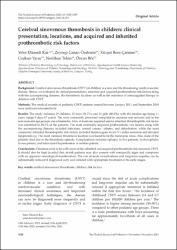| dc.contributor.author | Düzenli Kar, Yeter | |
| dc.contributor.author | Özdemir, Zeynep Canan | |
| dc.contributor.author | Çarman, Kürşat Bora | |
| dc.contributor.author | Yarar, Coşkun | |
| dc.contributor.author | Tekin, Neslihan | |
| dc.contributor.author | Bör, Özcan | |
| dc.date.accessioned | 2022-05-24T06:33:49Z | |
| dc.date.available | 2022-05-24T06:33:49Z | |
| dc.date.issued | 2021 | en_US |
| dc.identifier.citation | Kar, Y. D., Özdemir, Z. C., Çarman, K. B., Yarar, C., Tekin, N., & Bör, Ö. (2021). Cerebral sinovenous thrombosis in children: clinical presentation, locations, and acquired and inherited prothrombotic risk factors. The Turkish Journal of Pediatrics, 63(6), 1028-1037. | en_US |
| dc.identifier.uri | https://doi.org/10.24953/turkjped.2021.06.011 | |
| dc.identifier.uri | https://hdl.handle.net/20.500.12933/1062 | |
| dc.description.abstract | Background. Cerebral sinovenous thrombosis (CSVT) in children is a rare and life-threatening cerebrovascular disease. Hence, we evaluated its clinical presentations, inherited and acquired prothrombotic risk factors along with the accompanying diseases, the thrombosis locations as well as the outcomes of anticoagulant therapy in children with CSVT.
Methods. The medical records of pediatric CSVT patients treated between January 2011 and September 2018 were analyzed retrospectively.
Results. The study included 29 children, 15 boys (51.7%) and 14 girls (48.3%), with the median age being 11 years (range:3 days-17 years). The most commonly presented complaint in neonates was seizures and in the non-neonatal age groups was a headache. Also, at least one acquired and/or inherited thrombophilic risk factor was identified in 89.7% of the patients. The most commonly acquired prothrombotic risk factors along with the accompanying diseases included infections, central venous catheter, and dehydration, while the most commonly inherited thrombophilic risk factors included heterozygous factor-V Leiden mutation and elevated lipoprotein (a). The most common thrombosis location was found to be the transverse sinus. Also, none of the patients died due to the thrombotic episode. Complications included epilepsy in five patients, hydrocephalus in one patient, and intracranial hypertension in another patient.
Conclusions. Clinicians need to be well aware of the inherited and acquired prothrombotic risk factors in CSVT. It should also be kept in mind that at-risk patients may also present with nonspecific signs and symptoms with no apparent neurological manifestation. The risk of acute complications and long-term sequelae can be substantially reduced if diagnosed early and initiated with appropriate treatment at the early stages. | en_US |
| dc.language.iso | en | |
| dc.publisher | TURKISH J PEDIATRICS | en_US |
| dc.relation.ispartof | Turkish Journal of Pediatrics | |
| dc.rights | info:eu-repo/semantics/openAccess | en_US |
| dc.subject | Cerebral sinovenous thrombosis | en_US |
| dc.subject | Children | en_US |
| dc.subject | Risk factors | en_US |
| dc.title | Cerebral sinovenous thrombosis in children: clinical presentation, locations, and acquired and inherited prothrombotic risk factors | en_US |
| dc.type | Article | |
| dc.identifier.orcid | 0000-0003-2917-7750 | en_US |
| dc.department | AFSÜ, Tıp Fakültesi, Dahili Tıp Bilimleri Bölümü, Çocuk Sağlığı ve Hastalıkları Ana Bilim Dalı | en_US |
| dc.institutionauthor | Düzenli Kar, Yeter | |
| dc.identifier.doi | 10.24953/turkjped.2021.06.011 | |
| dc.identifier.volume | 63 | en_US |
| dc.identifier.issue | 6 | en_US |
| dc.identifier.startpage | 1028 | en_US |
| dc.identifier.endpage | 1037 | en_US |
| dc.relation.publicationcategory | Makale - Ulusal Hakemli Dergi - Kurum Öğretim Elemanı | en_US |
| dc.identifier.pmid | 35023653 | |
| dc.identifier.scopus | 2-s2.0-85122434168 | |
| dc.identifier.scopusquality | Q3 | |
| dc.identifier.trdizinid | 518304 | |
| dc.identifier.wos | WOS:000742662500004 | |
| dc.identifier.wosquality | Q4 | |
| dc.indekslendigikaynak | Web of Science | |
| dc.indekslendigikaynak | Scopus | |
| dc.indekslendigikaynak | TR-Dizin | |
| dc.indekslendigikaynak | PubMed | |
















